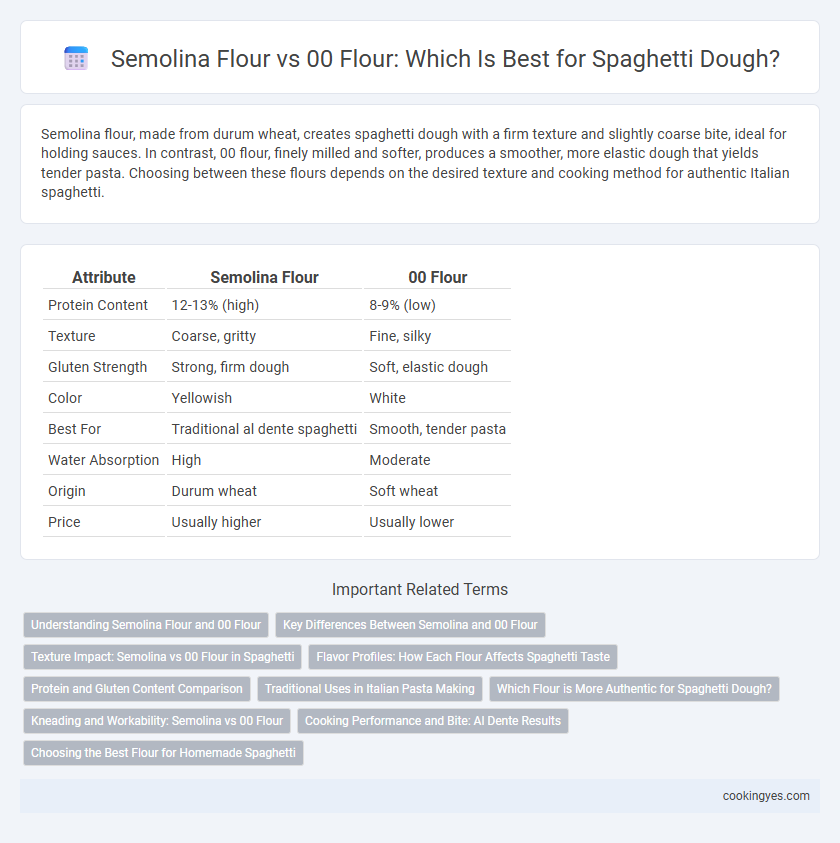Semolina flour, made from durum wheat, creates spaghetti dough with a firm texture and slightly coarse bite, ideal for holding sauces. In contrast, 00 flour, finely milled and softer, produces a smoother, more elastic dough that yields tender pasta. Choosing between these flours depends on the desired texture and cooking method for authentic Italian spaghetti.
Table of Comparison
| Attribute | Semolina Flour | 00 Flour |
|---|---|---|
| Protein Content | 12-13% (high) | 8-9% (low) |
| Texture | Coarse, gritty | Fine, silky |
| Gluten Strength | Strong, firm dough | Soft, elastic dough |
| Color | Yellowish | White |
| Best For | Traditional al dente spaghetti | Smooth, tender pasta |
| Water Absorption | High | Moderate |
| Origin | Durum wheat | Soft wheat |
| Price | Usually higher | Usually lower |
Understanding Semolina Flour and 00 Flour
Semolina flour, milled from durum wheat, offers a coarse texture and high protein content that provides the firm bite and golden color ideal for traditional spaghetti. 00 flour, finely milled from soft wheat, produces a silky dough with lower protein, resulting in a tender and delicate pasta texture favored in many Italian recipes. Understanding the distinct gluten structures and moisture absorption rates of semolina and 00 flour is essential for achieving desired pasta elasticity and cooking performance.
Key Differences Between Semolina and 00 Flour
Semolina flour, made from durum wheat, has a coarser texture and higher protein content, providing spaghetti dough with a firm, al dente bite and a slightly yellow hue. In contrast, 00 flour, finely milled from soft wheat, yields a silky, smooth dough with a tender texture and pale color, ideal for delicate pasta like tagliatelle. The choice between semolina and 00 flour affects dough elasticity, cooking time, and overall flavor, making semolina better suited for traditional spaghetti and 00 flour for softer pasta varieties.
Texture Impact: Semolina vs 00 Flour in Spaghetti
Semolina flour, made from durum wheat, produces spaghetti with a firm, slightly coarse texture that holds sauces well due to its high gluten content. In contrast, 00 flour, finely milled soft wheat, yields a smoother, silkier dough that creates tender, delicate spaghetti with a more refined mouthfeel. The choice between semolina and 00 flour significantly impacts spaghetti's bite and sauce absorption, influencing the overall pasta dining experience.
Flavor Profiles: How Each Flour Affects Spaghetti Taste
Semolina flour imparts a nutty, slightly sweet flavor to spaghetti, enhancing the pasta's overall taste with a hearty, rustic character. In contrast, 00 flour produces a more delicate, neutral flavor, allowing sauces and seasonings to stand out without interference from the dough. Choosing semolina strengthens the pasta's traditional Italian essence, while 00 flour creates a smoother, subtle backdrop for a refined dining experience.
Protein and Gluten Content Comparison
Semolina flour, derived from durum wheat, boasts a higher protein content, typically around 12-15%, which results in a stronger gluten network ideal for firm, al dente spaghetti texture. In contrast, 00 flour, finely milled from soft wheat, contains lower protein levels, usually between 8-11%, producing a softer, more delicate dough with less gluten development. The choice between semolina and 00 flour directly affects spaghetti's chewiness, elasticity, and ability to hold shape during cooking.
Traditional Uses in Italian Pasta Making
Semolina flour, made from durum wheat, is traditionally used in southern Italy for spaghetti dough due to its coarse texture and high protein content, providing a firm bite and excellent cooking resistance. In contrast, 00 flour, finely ground from soft wheat, is preferred in northern Italy for delicate pasta varieties, offering a smooth, elastic dough ideal for fresh pasta. Both flours reflect regional Italian pasta-making traditions, with semolina flour yielding a robust, al dente spaghetti and 00 flour producing a tender, refined texture.
Which Flour is More Authentic for Spaghetti Dough?
Semolina flour, made from durum wheat, is traditionally favored for authentic spaghetti dough due to its coarse texture and high protein content, which provides a firm bite and excellent pasta structure. In contrast, 00 flour, finely milled and lower in protein, yields a softer, more delicate dough commonly used in Italian fresh pasta but less ideal for al dente spaghetti. Choosing semolina flour maintains the classic texture and durability crucial for traditional Italian spaghetti recipes.
Kneading and Workability: Semolina vs 00 Flour
Semolina flour, with its coarse texture and high protein content, provides a firmer and more elastic dough that requires longer kneading to develop gluten properly, resulting in a chewier spaghetti texture. In contrast, 00 flour, finely milled and lower in protein, produces a softer, smoother dough that is easier to knead and roll, allowing for quicker workability and a silkier pasta finish. Choosing between semolina and 00 flour impacts kneading time and dough elasticity, directly influencing the spaghetti's bite and cooking performance.
Cooking Performance and Bite: Al Dente Results
Semolina flour, with its high protein content and coarse texture, creates spaghetti dough that maintains a firm, al dente bite and resists overcooking in boiling water, producing a robust texture ideal for traditional Italian pasta. In contrast, 00 flour, finely milled and lower in protein, yields a softer, more delicate spaghetti that cooks faster but may lack the distinctive bite, resulting in a tender yet less resilient pasta. For the best al dente results, semolina-based spaghetti offers superior cooking performance by retaining structure and chewiness during preparation.
Choosing the Best Flour for Homemade Spaghetti
Choosing the best flour for homemade spaghetti hinges on texture and gluten content, with semolina flour providing a coarser, firm bite due to its high protein and gluten levels. In contrast, 00 flour, finely milled from soft wheat, creates a silky, tender dough ideal for delicate pasta but may lack the semolina's characteristic chew. For authentic, al dente spaghetti, semolina flour is preferred, while 00 flour suits recipes aiming for a smoother, more elastic consistency.
Semolina flour vs 00 flour for spaghetti dough Infographic

 cookingyes.com
cookingyes.com